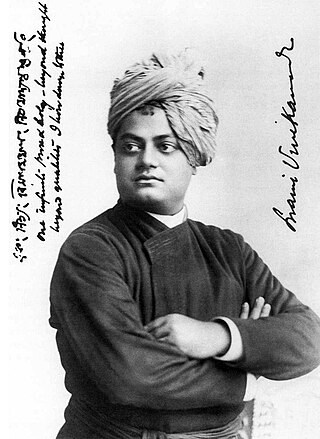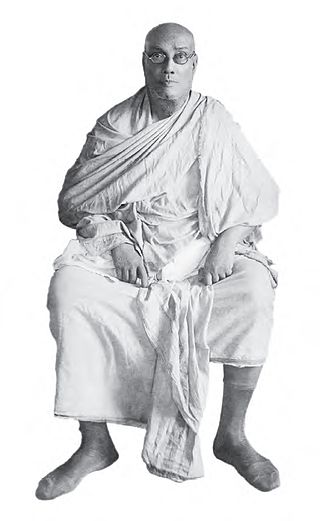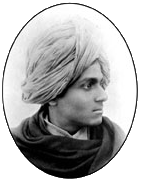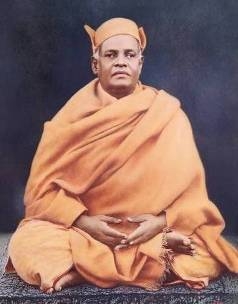
Swami Vivekananda, born Narendranath Datta, was an Indian Hindu monk, philosopher, author, religious teacher, and the chief disciple of the Indian mystic Ramakrishna. He was a key figure in the introduction of Vedanta and Yoga to the Western world, and the father of modern Indian nationalism who is credited with raising interfaith awareness and bringing Hinduism to the status of a major world religion.
Swami Gambhirananda (1899–1988), born as Jatindranath Datta, was a Hindu sanyasi associated with Ramakrishna Mission. He was born at Sadhuhati in today's Bangladesh. He graduated from Scottish Church College, Calcutta (Kolkata).

Swami Shivananda (1854–1934), born Tarak Nath Ghosal, was a Hindu spiritual leader and a direct disciple of Ramakrishna, who became the second president of the Ramakrishna Mission. His devotees refer to him as Mahapurush Maharaj. Shivananda and Subodhananda were the only direct disciples of Ramakrishna to be filmed. He was a Brahmajnani. Shivananda introduced the celebration of the birthdays of his brother-monks. He was known to have laid the foundation stone of Shri Ramakrishna Temple at Belur Math, which was designed by Vijnanananda.

Swami Vijnanananda was an Indian monk of Ramakrishna order, born in an upper-class family near Dakshineswar, and was a direct disciple of Ramakrishna. He was an engineer and worked as the District Engineer in the erstwhile State of United Provinces, India. He was a great scholar of Sanskrit with expertise in religio-philosophical works, astronomy, civil engineering etc. He spent considerable time in Allahabad (Prayag) centre of Ramakrishna Math. He became the President of Ramakrishna Mission in 1937. It was under his presidency and direct supervision that the Ramakrishna Temple at Belur Math was constructed and consecrated.

Swami Yatiswarananda was a vice-president of Ramakrishna Order, whose headquarter is in Belur Math. He was a disciple of Swami Brahmananda, a brother disciple of Swami Vivekananda and a direct disciple and spiritual son of Ramakrishna. He served in Philadelphia propagating the message of Vedanta. He was the president of Bangalore centre of Ramakrishna Math. He founded an ashrama in Switzerland.

Swami Virajananda, born Kalikrishna Bose, was an initiated disciple of Sarada Devi and the sixth president of the Ramakrishna Order. Born as the son of Trailokyanath Bose and Nishadkalidevi, Virajananda was the first person to join the Ramakrishna Order after the direct disciples of Ramakrishna. In 1897, he was initiated into sannyasa by Vivekananda. From 1899 onward he served in Advaita Ashrama, Mayavati and became its president in 1906. He is recognised as a monastic disciple of Vivekananda.

Ramakrishna Math is the administrative legal organization of the Ramakrishna Order, considered part of the Hindu reform movements. It was set up by sanyasin disciples of Ramakrishna Paramhansa headed by Swami Vivekananda at Baranagar Math in Baranagar, a place near Calcutta, in 1886. India. The headquarters of Ramakrishna Math and its twin organisation, Ramakrishna Mission is at Belur Math.

Swarupananda was a direct monastic disciple of Vivekananda and the first president of the Advaita Ashrama, set up by Vivekananda in 1899 at Mayavati, near Champawat. The ashram is a branch of the religious monastic order, Ramakrishna Math, also set up by Vivekananda on the teachings of his guru Ramakrishna.

Swami Yogananda was a disciple of Ramakrishna, the 19th-century mystic. He took his formal initiation from Sarada Devi, the "holy mother" of Ramakrishna Order and spiritual consort of Ramakrishna. He was the first vice-president of Ramakrishna Mission. He belonged to the family of Sabarna Roy Choudhury, an aristocratic family of erstwhile Bengal. He had a very short life, but he played a very important role during the formative years of Ramakrishna Mission. He was also a dedicated and devoted attendant to Sarada Devi during her stay in Calcutta after Ramakrishna's death. He was one of the disciples whom Ramakrishna referred to as "Iswarakoti" or the "ever perfect soul".

Saradananda, also known as Swami Saradananda, was born as Sarat Chandra Chakravarty in 1865, and was one of the direct monastic disciples of Ramakrishna. He was the first Secretary of the Ramakrishna Math and Ramakrishna Mission, a post which he held until his death in 1927. He established the Udbodhan house in the Bagbazar area of Calcutta, which was built primarily for the stay of Sri Sarada Devi in Calcutta, from where he used to publish the Bengali magazine Udbodhan. There he wrote Sri Sri Ramakrishna Lilaprasanga in Bengali, on the life of Ramakrishna, which was translated into English as Sri Ramakrishna, the Great Master. He is believed to be reincarnation of Saint Peter and he allegedly went into Samadhi when he was in the Saint Peter Church and said that "I remembered my past" and wrote in his diary that "Saint Peter again."

Josephine MacLeod was an American friend and devotee of Swami Vivekananda. She had a strong attachment to India and was an active participant in the Ramakrishna Vivekananda movement. She was given the nicknames "Tantine" and "Jo Jo" by Vivekananda. She considered Swami Vivekananda to be her friend and helped him with his finances. MacLeod was not a sanyasin, unlike many others such as Sister Nivedita or Sister Christine. She was instrumental in spreading Vivekananda's message on Vedanta in the West. She made many contributions to the initial and the later phases of the development of the order of Ramakrishna and Vivekananda. She was a contributor to many causes espoused by Sister Nivedita, the most famous disciple of Vivekananda, including that of contributing financially towards the development of the Indian National Movement especially in Bengal and elsewhere in India.

Swami Sadananda, born Sharat Chandra Gupta, popularly known as Gupta Maharaj in the Ramakrishna Order, was a direct monastic disciple of Swami Vivekananda. He was the first disciple according to some sources. He took his monastic vows and joined Baranagar Math to serve the other disciples of Sri Ramakrishna in 1888–89 and subsequently joined the Belur Math when it was established. He was one of the leaders of early Ramakrishna Mission in its relief work. One of his significant contributions was providing relief to the citizens of Calcutta during the plague epidemic of 1898–99. He traveled to Japan in 1903. His later days were spent in company of Sister Nivedita as her protector and guide. His notable contribution in the later part of his life was preaching the message of Swami Vivekananda, especially among youth.

Kalyanananda (1874–1937) was a direct monastic disciple of Vivekananda, who had set up the Ramakrishna Mission Sevashrama at Kankhal, near Haridwar. As a monk of the Ramakrishna Order, he took up service to the humanity as the most important philosophy in his life and practiced it for the benefit of the local population and the pilgrims. He spent thirty six-years in Ramakrishna Mission Sevashrama Kankhal to serve the poor and afflicted. He was one of the pioneers to set up a hospital in a remote location for the poor, needy and the itinerant monks who did not have access to healthcare.

Ramakrishna Mission Sevashrama, Kankhal (RKMS) is in its present form is a 210-bed multi-specialty charitable hospital in Kankhal, Haridwar in Uttarakhand. It is a branch of Ramakrishna Mission, and was established in 1901 by Swami Kalyanananda, one of the direct monastic disciples of Swami Vivekananda. The hospital serves the treatment needs of poor patients in and around Uttarakhand. Since its inception it has treated more than 10 million patients. From a modest beginning in a rented two room dilapidated building it has grown to be a multi-specialty hospital for treatment of impoverished and needy people, under the supervision of the monks of Ramakrishna Order. The hospital is located in an 18 acres campus, and houses Gynecology and Obstetrics, Pediatrics, Intensive Care Units, Pathological laboratory, Blood bank, Operation Theaters etc. in addition to dairy and agricultural land whose products are used for the consumption of poor in patients.

Nischayananda was an Indian monk who worked to help the poor and needy. He was a direct monastic disciple of Vivekananda. He, together with Kalyanananda was responsible for setting up and running the Ramakrishna Mission Sevashrama, Kankhal. He was inspired by Vivekananda's philosophy of serving man as God and dedicated his life to serve poor and downtrodden in the remote areas where no healthcare facility existed. He worked in military service before joining the Ramakrishna Order as a direct monastic disciple of Vivekananda. He met Vivekananda in Madras and decided to become his disciple. After Vivekananda's death, he went for pilgrimage and by chance came to Haridwar where he met his brother disciple Kalyanananda and joined him in carrying out the works of Ramakrishna Mission Sevashrama Kankhal.

Achalananda, popularly known as Kedar Baba, was a direct monastic disciple of Vivekananda and the founder of Ramakrishna Mission Home of Service, in Varanasi. He initially worked as a policeman, but was then influenced by the ideology of Vivekananda.

Sri Ramakrishna the Great Master, translated by Swami Jagadananda, is an English translation of the Bengali biography Sri Ramakrishna Leela Prasanga, of Sri Ramakrishna, the 19th-century Indian saint and mystic. Its Bengali original was written by Swami Saradananda, which is based on interviews of persons who knew or interacted with him. It is therefore a first-hand source. The original Bengali version published was composed in five volumes and was the first full-scale biography of the saint. This is an eyewitness account and therefore carries more credibility than later books on Sri Ramakrishna. The English translation was first published in 1952. The original Bengali book was written from 1909 to 1919, over a period of ten years, in order to repay the debt incurred for constructing Udbodhan House for Holy Mother Sri Sarada Devi.

Swami Prakashananda (1874–1927) was a monastic disciple of Vivekananda and a monk of the Ramakrishna Order who played a major role in propagating and promoting the Vedanta philosophy and Vivekananda's message in India and America. He came to the US in 1906 to serve under Trigunatitananda, a direct disciple of Ramakrishna at the Vedanta Society of San Francisco, later renamed as Vedanta Society of Northern California, and later became its president.
Vimalananda (1872–1908) was an Indian spiritual writer who was one of the monastic disciples of Vivekananda and an early monk of the Ramakrishna Order. He was involved in the publication of Prabuddha Bharata. He was actively involved in running day-to-day operations of the Advaita Ashrama at Mayavati during the early days of the Ashrama. He also inaugurated the Ramakrishna Math at Ulsoor in Bangalore in 1906. He died in 1908 at the Mayavati Ashrama.
Sri Sarada Math is named after Sri Sarada Devi, the consort of Sri Ramakrishna, and founded on 2 December 1954. Built by a group of eight sadhavis, as per the instructions given by Swami Vivekananda, it serves as a monastic order for women. Headquartered at Dakshineshwar, Kolkata, the organisation has branch centres all over India, in Sri Lanka and Australia. The nuns of this order use the title "Pravrajika" before their ordained name, and are usually addressed as "Mataji" meaning 'revered mother'.


















